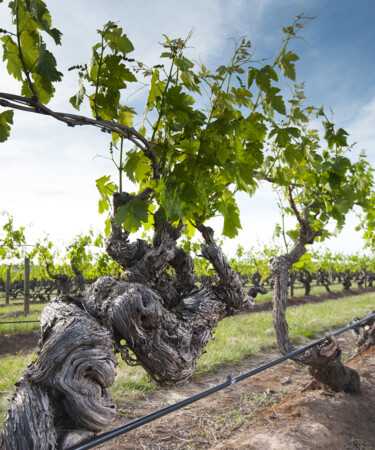There are many indications of quality on wine labels. In Burgundy we see Grand Cru or Premier Cru indicating that these wines came from prized vineyard plots and can fetch a higher price point. In Italy there are words like Riserva and Superiore telling the consumer that these wines are so special that they needed a few extra years in the bottle before release or that the alcohol level is lower, resulting in a more elegant wine. And these are just the tip of the iceberg. Depending on the region every place has their own way of communicating better quality under their particular laws. But there is one quality indicator used that is not required by law anywhere on the globe but it is a source of pride on the same level as all the law abiding words. It is the term Old Vine.
With American wines, we often see Old Vine mentioned on bottles of Californian Zinfandel. From France you’ll see the term Old Vine appear as vieilles vignes and the bottles will often come from the southern arch of the country. There are also some Spanish wines that say Old Vine, but I’ll get into those bottles in a bit because they are a special case and welcome surprise.
So what is going on here? Why would a winemaker want you to know that a particular wine was made from old ass vines if they are not required to by law? And how old does a vine have to be to be considered old?
The answer to the first question is equal parts marketing and pride. It’s widely agreed upon in the wine world that old vines make better wine. Because of this the term has become a marketing tool as well which is why you will even see the term on boxed wines like Bota Box Old Vine Zinfandel.
Newly planted vines take about three years to begin full cropping. They may produce fruit after a year or two but are often pruned before ripening. By the fifth or sixth year a vine is ready for annual harvesting, increases its vigour, the amount of a vine’s vegetative growth, and continues to grow for the next several decades. After about twenty or thirty years the vigour begins to decline. At the age of forty the vine is over the hill and produces less and less fruit. This decline increases until the vine is about fifty years old when the plant is in its twilight years. This is when the vigour generally plateaus.
This stage in a vine’s life is when winemakers refer to it as Old Vine. Just as there is no legislation on the term there is also no official age that defines the term but fifty years seems to be the agreed upon number. Vines can live much longer than this though. One of the oldest vines still producing fruit for production is just outside of London at the Hampton Court Palace. It is also the largest vine on record as of 2005 and was planted in 1769.
The reason wines from these gnarly Tim Burton like vines are considered high in quality is actually because they produce less grape bunches. And in doing so the resulting flavor of the wine is more concentrated. It all comes down to the exposure to sunlight. These old sages’ canopies, leaves, fruit and trunk, are thinner allowing for more daytime sun soaks and the food delivery system has less to fight with to get nutrients to the grapes. Often in these wines you will get soft concentrated fruit and tannin with a good amount of acidity. Where once these vines made wines of elegance, they now make wine that are regal.
So if these old vines are producing less fruit that would mean very low yields which should equal a higher price, right? Well yes and no. While there are many winemakers who produce incredible wines from low yields at a pretty penny, if you do a search on wine searcher you’ll also find a ton of Old Vine Zins from California that go for less than $10. So what gives? Because Zinfandel was planted during the gold rush and became so popular that it continued to be planted everywhere from the Sierra Foothills in the east to Sonoma and beyond, there is a ton of old vine Zinfandel in California. And we all know what excess supply does to price from our college economics course, right?
As of 2012 there were about 50,000 acres of land under zinfandel vines. Some of these vines are well over one hundred years old. And because there is really no rules about labeling, a wine brand can say Old Vine and only have a small percentage blended in for marketing purposes, which makes the quality of the lower price points spotty.
Which leads me to that Spanish wine I was talking about earlier. There two magical places in Northeastern Spain near Zaragoza and west of Barcelona called Calatayud and Cariñena. They are dry, arid places that grow the native Garnacha grape. The majority of the vines here are well over fifty years old and maintained by co-operatives, ventures owned collectively by many members, who are able to pool their resources cutting costs and enjoying EU protected subsidies. The result is an ocean of amazing Old Vine Garnacha wine that makes it to the US and is listed on shelves for as low as $8 a bottle. When I first started in wine retail I was floored by the quality to price ratio. These wines are wonderful and fruit forward with soft tannins and high acidity, all the gifts an Old Vine can give.
